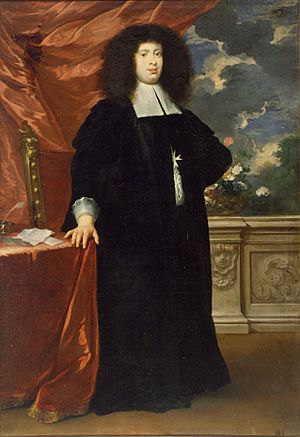Francesco Maria de' Medici, Duke of Rovere and Montefeltro facts for kids
Quick facts for kids Francesco Maria de' Medici |
|||||
|---|---|---|---|---|---|

Portrait by Justus Sustermans, 1678
|
|||||
| Duke of Montefeltro | |||||
| Reign | 6 March 1694 – 3 February 1711 | ||||
| Born | 12 November 1660 Pitti Palace, Florence, Tuscany |
||||
| Died | 3 February 1711 (aged 50) Bagno a Ripoli, Florence, Tuscany |
||||
| Spouse | Eleonora Luisa Gonzaga | ||||
|
|||||
| House | House of Medici | ||||
| Father | Ferdinando II de' Medici | ||||
| Mother | Vittoria della Rovere | ||||
| Religion | Roman Catholicism | ||||
Francesco Maria de' Medici (born November 12, 1660 – died February 3, 1711) was an important member of the House of Medici, a powerful family in Italy. He held several important roles during his life. He was a governor, a cardinal, and later inherited a duchy from his mother.
Contents
Early Life and Family
Francesco Maria was born in Florence, Italy. His parents were Ferdinando II de' Medici, Grand Duke of Tuscany and Vittoria della Rovere. He was the second son in the family. His older brother was Cosimo de' Medici. Francesco Maria also had important cousins, like a bishop in Austria and the Duke of Mantua.
Important Roles and Influence
In 1683, Francesco Maria became the governor of Siena. He kept this important job until he passed away. Three years later, in 1686, he was made a cardinal. A cardinal is a high-ranking official in the Catholic Church. He got special permission from Pope Innocent XI to become one.
Francesco Maria had a lot of influence in choosing new Popes. He played a big part in the Papal elections, called conclaves, in 1689 and 1700. Even with his influence in the Papal States, he mostly lived at his country home. This home was called Villa di Lappeggi, located outside Florence. He made sure the villa was fixed up and became a place for parties and fun gatherings.
Inheriting a Duchy
When his mother died in 1694, Francesco Maria inherited her lands. These lands included the Duchies of Rovere and Montefeltro. These were special family properties that once belonged to the House of La Rovere.
He also helped guide his nephew, Grand Prince Ferdinando. Ferdinando was the heir to the throne of Tuscany.
A Difficult Marriage
The Grand Prince Ferdinando and his wife did not have any children. This was a problem for the future of the Tuscan family. The Grand Duke, Cosimo III, looked to his brother Francesco Maria for help. Another family member, Prince Gian Gastone, also did not have children.
In 1709, Francesco Maria's health was not good. He was allowed to step down from being a cardinal. He was then asked to marry Eleonora Luisa Gonzaga. This marriage was an attempt to help the family have an heir. They were married by proxy in June 1709 and in person in July 1709.
Eleonora Luisa was considered a very attractive woman. However, the marriage was not successful. Eleonora Luisa did not want to be with her husband. He was twenty-six years older than her. Eventually, the marriage was completed, but they did not have any children. This made Francesco Maria very sad.
Later Life and Death
Francesco Maria retired to Bagno a Ripoli. He died there in 1711. He passed away from a condition called dropsy, which causes swelling in the body. He left behind many debts. His wife lived until 1742, but she became mentally unwell.
Ancestry
| Ancestors of Francesco Maria de' Medici, Duke of Rovere and Montefeltro | |||||||||||||||||||||||||||||||||||||||||||||||||||||||||||||||||||||||||||||||||||||||||||||||||||||||||||||||||||||||||||||||||||||||||||||||||||||||||||||||||||||||||||||||||||||||||||||||||||||||||||||||||||||||||||||||||||||||||||||||||||||||||||||||||||||||||||||||||||||||||
|---|---|---|---|---|---|---|---|---|---|---|---|---|---|---|---|---|---|---|---|---|---|---|---|---|---|---|---|---|---|---|---|---|---|---|---|---|---|---|---|---|---|---|---|---|---|---|---|---|---|---|---|---|---|---|---|---|---|---|---|---|---|---|---|---|---|---|---|---|---|---|---|---|---|---|---|---|---|---|---|---|---|---|---|---|---|---|---|---|---|---|---|---|---|---|---|---|---|---|---|---|---|---|---|---|---|---|---|---|---|---|---|---|---|---|---|---|---|---|---|---|---|---|---|---|---|---|---|---|---|---|---|---|---|---|---|---|---|---|---|---|---|---|---|---|---|---|---|---|---|---|---|---|---|---|---|---|---|---|---|---|---|---|---|---|---|---|---|---|---|---|---|---|---|---|---|---|---|---|---|---|---|---|---|---|---|---|---|---|---|---|---|---|---|---|---|---|---|---|---|---|---|---|---|---|---|---|---|---|---|---|---|---|---|---|---|---|---|---|---|---|---|---|---|---|---|---|---|---|---|---|---|---|---|---|---|---|---|---|---|---|---|---|---|---|---|---|---|---|---|---|---|---|---|---|---|---|---|---|---|---|---|---|---|---|---|---|---|---|---|---|---|---|---|---|---|---|---|---|---|---|---|
|
|||||||||||||||||||||||||||||||||||||||||||||||||||||||||||||||||||||||||||||||||||||||||||||||||||||||||||||||||||||||||||||||||||||||||||||||||||||||||||||||||||||||||||||||||||||||||||||||||||||||||||||||||||||||||||||||||||||||||||||||||||||||||||||||||||||||||||||||||||||||||
See also
 In Spanish: Francisco María de Médici para niños
In Spanish: Francisco María de Médici para niños
Images for kids


